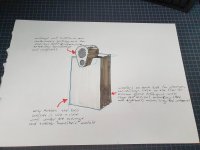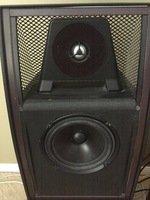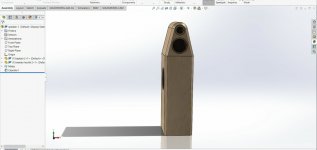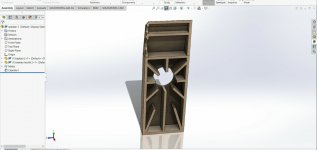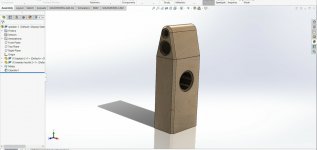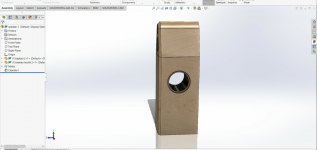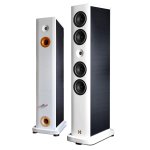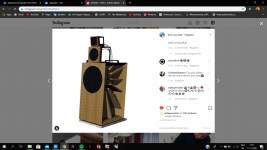Hello,
I'm designing new cabinets and I thought it would be nice to keep the baffle surface around the tweeter and midrange as small as possible to give the ultimate openness, airyness (?) and soundstage.
I came up with this, the tweeter and midramge are in a very small sort of bookshelf on top of the bass cabinet. This is very small. Though, the bass cabinet is like a wall, this will only cause worse reflections. What do you think. Line that wall of the bass cabinet with sound dampening and will it be very good or will it be better of with just a normal large baffle?
I'm designing new cabinets and I thought it would be nice to keep the baffle surface around the tweeter and midrange as small as possible to give the ultimate openness, airyness (?) and soundstage.
I came up with this, the tweeter and midramge are in a very small sort of bookshelf on top of the bass cabinet. This is very small. Though, the bass cabinet is like a wall, this will only cause worse reflections. What do you think. Line that wall of the bass cabinet with sound dampening and will it be very good or will it be better of with just a normal large baffle?
Attachments
Looks like diffraction will become significant here.
What makes you think the baffle has a negative impact on the imaging?
Looks to me like the design would be better off if it was build as a small bookshelf and a subwoofer seperately.
What makes you think the baffle has a negative impact on the imaging?
Looks to me like the design would be better off if it was build as a small bookshelf and a subwoofer seperately.
The opposite woofers are the only positive. That small MT baffle, with forward offset, will bring you problems, quite significant problems.
Last edited:
This is what diffraction nightmares are made of.
If you want openness or airy ness, build an OB. Your tweeter will still need a baffle.
If you want openness or airy ness, build an OB. Your tweeter will still need a baffle.
Troels G was asked by a customer to 'fix' his speakers.
They used top end of scan speak drivers.
The tweeter was suspension mounted with no baffle.
Someone online suggested a certain crossover.
Troels did measurements of the raw drivers as they were mounted, and with the suggested crossover.
Hideous beyond any comprehensible belief.
Sorry but I don't remember the page or have a link.
But it was one of his private customers.
In short, I think you will have so many major issues with trying to make your design function that you will end up throwing it out.
EDIT.
Found it.
Crossovers
Scroll down to "Example".
And I was wrong. It wasn't scan drivers, it was Accutons.
They used top end of scan speak drivers.
The tweeter was suspension mounted with no baffle.
Someone online suggested a certain crossover.
Troels did measurements of the raw drivers as they were mounted, and with the suggested crossover.
Hideous beyond any comprehensible belief.
Sorry but I don't remember the page or have a link.
But it was one of his private customers.
In short, I think you will have so many major issues with trying to make your design function that you will end up throwing it out.
EDIT.
Found it.
Crossovers
Scroll down to "Example".
And I was wrong. It wasn't scan drivers, it was Accutons.
Last edited:
Cabinets....
WHY NOT... copy off the Smart Kids? and leverage 70 years of research?
----Avalon "Compas" has both a high functionality truncated pyramid and sexy bevel cuts
----Several companies use large radius edge rounds for reduced distortion(B&W, Magico Q5, Kii, Dutch & Dutch, etc... ).
----Several companies use slanted baffles with edge bevel cuts(Nelson Pass...)
----Free, good CAD tools are available
WHY NOT... copy off the Smart Kids? and leverage 70 years of research?
----Avalon "Compas" has both a high functionality truncated pyramid and sexy bevel cuts
----Several companies use large radius edge rounds for reduced distortion(B&W, Magico Q5, Kii, Dutch & Dutch, etc... ).
----Several companies use slanted baffles with edge bevel cuts(Nelson Pass...)
----Free, good CAD tools are available
i would reconsider the equal distance to the floor for the woofers, to me it sounds a lot better having the woofers placed at non symmetric distances to floor and ceiling = less resonant low freq response
Cabinets
Phase: What Dahlquist model is that? Have never seen one similar.
Maybe find some used Dahlquist, are very nice...
Phase: What Dahlquist model is that? Have never seen one similar.
I've already designed something completely different. It looks like Marten Coltrane 3 with woofers on the side. They are now 2/3 of the bass cabinets height up from the floor (so the are on the upper side). This indeed prevents resonances and standing waves within the cabinet and room. And because the distance between the woofers and midrange is smaller, there is a far smaller phase difference for better phase coherence and tighter imaging. There's also something special about the inside of the bass cabinets. These baffles in the inside eliminate standing waves and because of the diverging shape they prevent compression and improve dynamics. I think this will greatly improve the neutrality and prevent boxiness of the bass.
The baffle get's narrower at the midrange and tweeter and has chamfered edges to prevent diffraction.
The baffle get's narrower at the midrange and tweeter and has chamfered edges to prevent diffraction.
Attachments
The woofer bracing is very nice.
Have you modelled the baffle in vituixCAD to see what effects the diffraction and baffle step has?
It's much easier to see what the speaker does than to model it in solidworks and pray that it works out or to ask someone else.
Though I like this design much more than the previous one.
Have you modelled the baffle in vituixCAD to see what effects the diffraction and baffle step has?
It's much easier to see what the speaker does than to model it in solidworks and pray that it works out or to ask someone else.
Though I like this design much more than the previous one.
The woofers are mounted on the sides in opposite directions. This results in the woofers cancelling out each other´s vibration, leaving a vibrationless cabinet. The volume of the bass enclosure is bigger for better room integration, reduced compression and deeper frequency response. And there´s something special about the inside of the cabinet. These diverging baffles are meant to pretty much eliminate standing waves and resonances in the cabinet. And because of the diverging shapes, the go against compression, enhancing dynamics. The sides of the cabinets of Kroma Audio speakers also have a diverging shape, the rear of the speakers is wider than the front, for the same reason and they are some exceptionally dynamic speakers. I can tell from experience having spent some time with them. Livio Cucuzza, the head designer of Sonus Faber, has these same baffles inside of his own personal reference system as well. These baffles at the same time make the cabinet very stiff because they are basically huge braces around the woofers.
Another advantage of having the woofers on the sides is timing. When you have the woofers mounted on the front, with one under the other, the bottom woofer is slightly furthes away from your ear than te upper woofer. The way to solve this is slant or curve the baffle to bring the bottom woofer more forward but this still only gives a fixed sweetspot. Having the woofers on the sides, they are at equal distance from your ears, enhancing timing and speed.
I've placed the woofers at 2/3 the height of the bass cabinet from the floor. So the are on the higher side of the cabinet. The unequal distance between the woofers and the top and bottom of the cabinet further prevents standing waves in the cabinet and because of the unequal distance of the woofers to the floow and ceiling also prevents standing waves within the room. Also, because the woofers are on the higher side of the cabinet, the distance to the midrange is smaller. This makes for a smaller difference in phase between the midrange and woofers. This is good for crossover integration and imaging. The reason why it's good for imaging is because the sound is coming from a smaller, less spread out location. The closer the point where the sound is coming from, the better the imaging. This is why coaxials have such phenominal imaging.
So all in all, what this design should offer is very well controlled, dynamic, natural and non-boxy bass with great speed and timing and a lack of standing waves.
I'm really looking forward to hearing the bass of these.
Furthermore. Above the bass cabinet, the baffle gets narrower towards the midrange and tweeter. Having the midrange and tweeter on a narrower baffle enhances soundstage and imaging and really makes the speakers disappear. For example, I can tell with experience that the Wilson Audio Sabrina disappears quite well. The Grimm LS1Be are very locatable in my opinion. The edges are chamfered. This prevents diffraction.
Instead of the midrange, the tweeter is now on top with the midrange under it. Why? When we look at where the image forms. The higher frequencies are most determing. The tweeter is most determing for where the image that we hear will form. With the midrange only slightly pulling it towards it. So, we want the tweeter at ear-height (1,1 m) or slightly higher. To do this with the midrange on top, the speaker would have to be very tall. Which the previous one was. With the tweeter on top. We can get the tweeter at ear-height without having to make the cabinet a lot taller than than. The previous one was massive with 1,3 m height. This one is only 1,2 m. Together with the narrower top of this design, this cabinet is much more compact which is nice for easthetics. Though we don't compromise sound, in fact, we enhance it.
Another advantage is that having the midrange on the bottom means the distance to the woofers is smaller. This again like I explained earlier makes for a smaller phase difference.
Then the inside of the midrange chamber. This was a big topic in my previous designs and I put a lot of effort in it but now I know, this was unnecessary. The main purpose of the design was to prevent standing waves but also to diffuse. Diffusion inside of the cabinet is useless. In the room it is usefull to diffuse reflections but not inside of the cabinets. Diffusion still leaves the reflection, it just scatters them making for a time difference. Inside of the cabinet, you don't want any reflections bouncing around at all. All you need to do inside of the cabinet is prevent standing waves. At the end the internal reflections just have to be absorbed using damping material. To achieve this you don't have to get so complicated. All it takes is nonparallel walls. Which is what I did. The side walls already are nonparallel because of the shape of the cabinet. Then I will simply place a slanted baffle in the back of the midrange cabinet (not in the drawing yet). This prevents standing waves. The sound will eventually be absorbed using damping material.
So what have we got in the end:
-Theoratically no vibrations from the woofers.
-Overall much better quality bass and better room integration.
-Narrower and better shaped baffle for better soundstage, imaging, difraction and smoother frequency response.
-Drivers are closer to each other for smaller phase difference and better imaging.
-Centre image is at ear-height.
-Lack of standing waves.
-Much more compact and easthetically appealing cabinet.
This is the complete explenation of this design.
I might look into that software but for now I will indeed just assume the difraction will be quite well behaved.
Another advantage of having the woofers on the sides is timing. When you have the woofers mounted on the front, with one under the other, the bottom woofer is slightly furthes away from your ear than te upper woofer. The way to solve this is slant or curve the baffle to bring the bottom woofer more forward but this still only gives a fixed sweetspot. Having the woofers on the sides, they are at equal distance from your ears, enhancing timing and speed.
I've placed the woofers at 2/3 the height of the bass cabinet from the floor. So the are on the higher side of the cabinet. The unequal distance between the woofers and the top and bottom of the cabinet further prevents standing waves in the cabinet and because of the unequal distance of the woofers to the floow and ceiling also prevents standing waves within the room. Also, because the woofers are on the higher side of the cabinet, the distance to the midrange is smaller. This makes for a smaller difference in phase between the midrange and woofers. This is good for crossover integration and imaging. The reason why it's good for imaging is because the sound is coming from a smaller, less spread out location. The closer the point where the sound is coming from, the better the imaging. This is why coaxials have such phenominal imaging.
So all in all, what this design should offer is very well controlled, dynamic, natural and non-boxy bass with great speed and timing and a lack of standing waves.
I'm really looking forward to hearing the bass of these.
Furthermore. Above the bass cabinet, the baffle gets narrower towards the midrange and tweeter. Having the midrange and tweeter on a narrower baffle enhances soundstage and imaging and really makes the speakers disappear. For example, I can tell with experience that the Wilson Audio Sabrina disappears quite well. The Grimm LS1Be are very locatable in my opinion. The edges are chamfered. This prevents diffraction.
Instead of the midrange, the tweeter is now on top with the midrange under it. Why? When we look at where the image forms. The higher frequencies are most determing. The tweeter is most determing for where the image that we hear will form. With the midrange only slightly pulling it towards it. So, we want the tweeter at ear-height (1,1 m) or slightly higher. To do this with the midrange on top, the speaker would have to be very tall. Which the previous one was. With the tweeter on top. We can get the tweeter at ear-height without having to make the cabinet a lot taller than than. The previous one was massive with 1,3 m height. This one is only 1,2 m. Together with the narrower top of this design, this cabinet is much more compact which is nice for easthetics. Though we don't compromise sound, in fact, we enhance it.
Another advantage is that having the midrange on the bottom means the distance to the woofers is smaller. This again like I explained earlier makes for a smaller phase difference.
Then the inside of the midrange chamber. This was a big topic in my previous designs and I put a lot of effort in it but now I know, this was unnecessary. The main purpose of the design was to prevent standing waves but also to diffuse. Diffusion inside of the cabinet is useless. In the room it is usefull to diffuse reflections but not inside of the cabinets. Diffusion still leaves the reflection, it just scatters them making for a time difference. Inside of the cabinet, you don't want any reflections bouncing around at all. All you need to do inside of the cabinet is prevent standing waves. At the end the internal reflections just have to be absorbed using damping material. To achieve this you don't have to get so complicated. All it takes is nonparallel walls. Which is what I did. The side walls already are nonparallel because of the shape of the cabinet. Then I will simply place a slanted baffle in the back of the midrange cabinet (not in the drawing yet). This prevents standing waves. The sound will eventually be absorbed using damping material.
So what have we got in the end:
-Theoratically no vibrations from the woofers.
-Overall much better quality bass and better room integration.
-Narrower and better shaped baffle for better soundstage, imaging, difraction and smoother frequency response.
-Drivers are closer to each other for smaller phase difference and better imaging.
-Centre image is at ear-height.
-Lack of standing waves.
-Much more compact and easthetically appealing cabinet.
This is the complete explenation of this design.
I might look into that software but for now I will indeed just assume the difraction will be quite well behaved.
I don't want to diminish your motivation, just a few thoughts.The woofers are mounted on the sides in opposite directions. This results in the woofers cancelling out each other´s vibration, leaving a vibrationless cabinet.
Another advantage of having the woofers on the sides is timing. When you have the woofers mounted on the front, with one under the other, the bottom woofer is slightly furthes away from your ear than te upper woofer. The way to solve this is slant or curve the baffle to bring the bottom woofer more forward but this still only gives a fixed sweetspot. Having the woofers on the sides, they are at equal distance from your ears, enhancing timing and speed.
The unequal distance between the woofers and the top and bottom of the cabinet further prevents standing waves in the cabinet and because of the unequal distance of the woofers to the floow and ceiling also prevents standing waves within the room.
The opposite woofer placement not prevents vibrations, just reduces some type of it if executed properly.
The timing thing only works with a woofer configuration like this, if you use just one speaker in front of you, with a stereo setup, the "outside" woofers are further away from you than the "inside" ones.
Standing waves cannot be eliminated in a closed space like a loudspeaker box or listening room, just reduced their effect somewhat by spreading out in the spectrum to not cause big problems.
Otherwise, your plans looks promising at first sight!
I like your design a lot, especially the internal bracing. I'm going to copy that.
The only thing I would change is the position of the woofers. Woofers near the floor give smoother in room frequency response. Depending on the crosover, that is.
But even better is to use multiple subs, for the best in room frequency response.
The only thing I would change is the position of the woofers. Woofers near the floor give smoother in room frequency response. Depending on the crosover, that is.
But even better is to use multiple subs, for the best in room frequency response.
The opposite woofer placement not prevents vibrations, just reduces some type of it if executed properly.
If the woofers are EXACTLY the same (no manufacturing tolerances etc) and placed on the EXACT opposite. They vibrations would cancel eachother out, right?
The timing thing only works with a woofer configuration like this, if you use just one speaker in front of you, with a stereo setup, the "outside" woofers are further away from you than the "inside" ones.
I doubt timing would be a problem anyway. The wavelengths are so long. As long as OP places them within 1/4th lambda (of the xover frequency) he should be fine.
If timing would be a severe probem you would recognize it in directivity. There'd be a point where they fully cancel out.
If he uses a DSP he can actually make a fair attempt at creating a perfect stepresponse by using inverse allpass filters to correct the phase. I'm not sure whether miniDSP or Hypex allows for this though.
Standing waves cannot be eliminated in a closed space like a loudspeaker box or listening room, just reduced their effect somewhat by spreading out in the spectrum to not cause big problems.
Why do standing waves operate differently in a box than in a room? Isn't the box just a very small room? The standing wave frequencies are just a lot smaller (kHz range instead of low hundreds, maybe even <100).
Sure damping material is far more effective to treat standing waves, but you need to brace anyway. You might as well use bracing that lowers the standingwaves.
This is an interesting project.
By comparison this isn't a significant concern next to the vertical separation of the two woofers which would be providing directivity, and forcing an even lower crossover to be considered. Whether this directivity would be good or not depends on the design, it is just another thing to figure in.
The vertical separation may also come into play between the woofers and mid.
I like to put numbers to things like this. Hypothetically.. listening at 2.5m, a tweeter at 1m and an 8" woofer directly below it and an 8" woofer touching the floor, this should be workable as long as you cross below maybe 800Hz (in practice I wouldn't put the woofer on the floor in a case like this, and the limit could probably be higher)....is timing. When you have the woofers mounted on the front, with one under the other, the bottom woofer is slightly furthes away from your ear than te upper woofer.
By comparison this isn't a significant concern next to the vertical separation of the two woofers which would be providing directivity, and forcing an even lower crossover to be considered. Whether this directivity would be good or not depends on the design, it is just another thing to figure in.
The vertical separation may also come into play between the woofers and mid.
Could you provide the woofer height, mid driver height, cabinet depth (front to back dimension) and wanted crossover frequency please.3wayaddict said:I've placed the woofers at 2/3 the height of the bass cabinet from the floor.
Bass cabinet dimension are 42,5 cm deep, 30 cm wide and 85 cm high. The woofer is placed with the middle point at 55,8 cm up from the bottom. Total cabinet height is 120 cm. For the crossovers I was thinking about ~250 Hz woofer to mid and 2,5 kHz mid to tweeter.
Last edited:
If the woofers are EXACTLY the same (no manufacturing tolerances etc) and placed on the EXACT opposite. They vibrations would cancel eachother out, right?
Exactly. When the forces of the woofers are placed in opposite directions the counteract and cancel each other out. And it works, look at the KEF Blade, Devialet Phantom and Vivid Audio Kaya and Giya speaker for example.
Fres = Fw - Fw = 0 (Fw being the force of a woofer).
I'm thinking the same. Though when looking at many of the high end manufacturers, they also often place the woofers very low to the bottom, even when they have the room to put it somewhere else. Look at YG Acoustics, Estelon, Von Schweikert. But then also they more often don't really seem to care about the height. I'll have to look into that.Why do standing waves operate differently in a box than in a room? Isn't the box just a very small room? The standing wave frequencies are just a lot smaller (kHz range instead of low hundreds, maybe even <100).
Sure damping material is far more effective to treat standing waves, but you need to brace anyway. You might as well use bracing that lowers the standingwaves.
I think I'm gonna do something similar to the bass cabinet in the midrange cabinet as well.
- Home
- Loudspeakers
- Multi-Way
- Designing new cabinets, what do you think?
